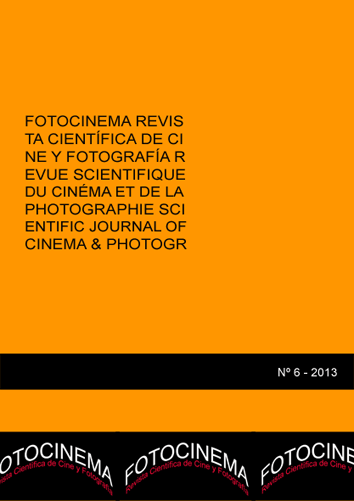Los puentes de Madison: una mirada de género
DOI:
https://doi.org/10.24310/Fotocinema.2013.v0i6.5915Abstract
<!-- /* Font Definitions */ @font-face {font-family:Times; panose-1:2 0 5 0 0 0 0 0 0 0; mso-font-charset:0; mso-generic-font-family:auto; mso-font-pitch:variable; mso-font-signature:3 0 0 0 1 0;} @font-face {font-family:"Cambria Math"; panose-1:2 4 5 3 5 4 6 3 2 4; mso-font-charset:0; mso-generic-font-family:auto; mso-font-pitch:variable; mso-font-signature:-536870145 1107305727 0 0 415 0;} @font-face {font-family:Georgia; panose-1:2 4 5 2 5 4 5 2 3 3; mso-font-charset:0; mso-generic-font-family:auto; mso-font-pitch:variable; mso-font-signature:3 0 0 0 1 0;} /* Style Definitions */ p.MsoNormal, li.MsoNormal, div.MsoNormal {mso-style-unhide:no; mso-style-qformat:yes; mso-style-parent:""; margin:0cm; margin-bottom:.0001pt; mso-pagination:widow-orphan; font-size:12.0pt; mso-bidi-font-size:10.0pt; font-family:Times; mso-fareast-font-family:Times; mso-bidi-font-family:"Times New Roman"; mso-no-proof:yes;} p.MsoHeader, li.MsoHeader, div.MsoHeader {mso-style-unhide:no; mso-style-link:"Encabezado Car"; margin:0cm; margin-bottom:.0001pt; mso-pagination:widow-orphan; tab-stops:center 212.6pt right 425.2pt; font-size:12.0pt; mso-bidi-font-size:10.0pt; font-family:Times; mso-fareast-font-family:Times; mso-bidi-font-family:"Times New Roman"; mso-no-proof:yes;} span.EncabezadoCar {mso-style-name:"Encabezado Car"; mso-style-unhide:no; mso-style-locked:yes; mso-style-link:Encabezado; mso-ansi-font-size:12.0pt; mso-no-proof:yes;} .MsoChpDefault {mso-style-type:export-only; mso-default-props:yes; font-size:10.0pt; mso-ansi-font-size:10.0pt; mso-bidi-font-size:10.0pt; font-family:Times; mso-ascii-font-family:Times; mso-fareast-font-family:Times; mso-hansi-font-family:Times;} @page WordSection1 {size:595.3pt 841.9pt; margin:70.9pt 3.0cm 70.9pt 3.0cm; mso-header-margin:14.2pt; mso-footer-margin:35.45pt; mso-columns:2 not-even 194.9pt 35.4pt 194.9pt; mso-paper-source:0;} div.WordSection1 {page:WordSection1;} @page WordSection2 {size:612.0pt 792.0pt; margin:70.85pt 3.0cm 70.85pt 3.0cm; mso-header-margin:36.0pt; mso-footer-margin:36.0pt; mso-paper-source:0;} div.WordSection2 {page:WordSection2;} -->Más allá del uso estereotipado y los lugares comunes del amor romántico y el drama, en la película Los puentes de Madison de Clint Eastwood se dibujan y se cuestionan las estrategias familiares y los roles de género de las mujeres rurales estadounidenses en los años 60 a través de su curso vital y de las relaciones sociales establecidas.
Abordando cuestiones esenciales para el movimiento feminista como la maternidad, la sexualidad de la mujer, la identidad o la doble jornada en el sector agrícola y haciendo un gran uso del lenguaje audiovisual, la adaptación cinematográfica de la novela de Robert James Waller pone el acento (ya sea de forma intencionada o casual) en los tabúes de las mujeres de la época y en los mandatos de género que éstas debían asumir.
Palabras clave: Cine; género; Eastwood; Madison; maternidad; sexualidad.
Abstract:
Beyond the stereotyped used of romantic love and drama on Clint Eastwood’s film The Bridges of Madison County are also shown and questioned family strategies and gender roles of rural women in the 1960s at United States through their lifes and established social relations.
Dealing with feminist movement key issues as motherhood, female sexuality, identity, or the double work time on the agricultural sector and making extensive use of audiovisual language, the filmed adaptation of the novel written by Robert James Waller focuses on (either deliberately or accidentaly) the taboos of the time women and gender mandates they sould assume.
Keywords: Cinema; gender; Eastwood; Madison; motherhood; sexuality.
Downloads
Metrics
Downloads
Published
How to Cite
Issue
Section
License
All contents published in Fotocinema Revista científica de cine y fotografía are protected under the Creative Commons Attribution-NonCommercial-ShareAlike 4.0 International (CC BY-NC-SA 4.0) license. All about this license is available in the following link: <http://creativecommons.org/licenses/by-nc-sa/4.0>
Users can copy, use, redistribute, share and exhibit publicly as long as:
- The original source and authorship of the material are cited (Journal, Publisher and URL of the work).
- It is not used for comercial purposes.
- The existence of the license and its especifications are mentioned.
There are two sets of authors’ rights: moral and property rights. Moral rights are perpetual prerogatives, unrenounceable, not-transferable, unalienable, imprescriptible and inembargable. According to authors’ rights legislation, Fotocinema. Revista científica de cine y fotografía recognizes and respects authors moral rights, as well as the ownership of property rights, which will be transferred to University of Malaga in open access. The property rights are referred to the benefits that are gained by the use or the dissemination of works. Fotocinema. Revista científica de cine y fotografía is published in an open access form and it is exclusively licenced by any means for doing or authorising distribution, dissemination, reproduction, , adaptation, translation or arrangement of works.
Authors are responsable for obtaining the necessary permission to use copyrighted images.













13.png)




